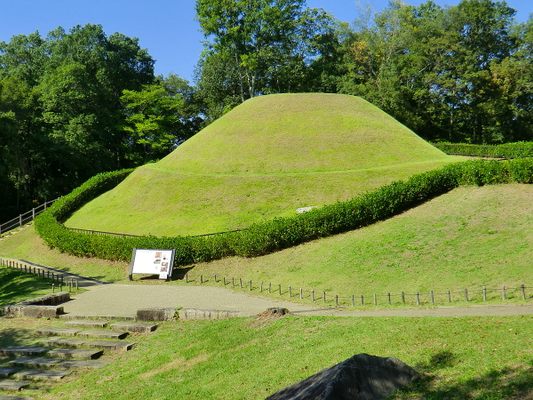About
Scholars have long known that ancient Japan borrowed much of its philosophy and religion from China and Korea; Buddhism arrived from the continent in the 6th century, and by the mid-7th century the ideology of Confucius was prevalent in the island kingdom then known as Yamato.
But just how great was the sway of Chinese culture upon early Japan? Because old records are scarce, and not necessarily accurate in accounting the island’s relationship with the continent, archaeologists have looked to Japan’s tumuli, or burial mounds, for clues. And few such tombs provide as much evidence of the early cultural connections between China and Japan as the sarcophagus of Takamatsuzuka in Asuka.
Fascinating artifacts have emerged from the old tombs of Japan. Ceremonial bronze mirrors, identical to those produced in China, have been unearthed from burial mounds as famous as that of the 4th-century Japanese emperor Nintoku. In 1968, a sword inscribed with golden ideograms, telling the eight-generation lineage of a warrior chieftain, was unearthed from a 5th-century mound just an hour from present-day Tokyo. Relics like these—indicative of trade with China, and proving the use of the Chinese written language in Japan—offer clear evidence of the culture’s early affinity with the mainland.
Perhaps the most telling of all finds was made in 1972, at Takamatsuzuka (the Tall Pine Tumulus) in the ancient Japanese town of Asuka. As the story goes, a local farmer was digging into a hillock to store a clutch of ginger when he struck quarried stone beneath the turf. Researchers were called to investigate, and soon excavated and opened what was, in fact, a crypt. Inside they found plastered walls, for the most part intact, covered in colored frescoes nearly 1,300 years old.
The old saw about a picture painting a thousand words is no exaggeration; these murals spoke volumes about this point in Japanese history. From the colorfully robed men and women holding frilled parasols and fans, and the mythical creatures—dragons, white tigers, and turtle-snakes—adorning the walls, to the celestial asters on the ceiling—with the sun and moon rendered below in gold and silver flake—emerges a vivid impression of the culture and worldview of the times. What's more, all of the depictions bear a striking resemblance to the art and haute culture of the contemporaneous Tang Dynasty of China.
Takamatsuzuka was once thought to be the tomb of the emperor Monmu. Today, no one is certain for whom the colorful sarcophagus was created, much less who painted it. Perhaps it was for a relative of the emperor, or a high-ranking court official, or possibly even a wealthy foreigner. It is said that Asuka was at the time an enclave of toraijin, "those who have crossed over the seas."
There is likely much more that could be learned from the exploration of Japan’s tumuli, of which there are many, large and small, but today Japan's Imperial Household Agency strictly controls investigation of the larger sites. While this is ostensibly done to protect the sanctity of the royal dead, it has a significant further effect. It ensures that nothing inconvenient is revealed about Japan’s early relationship with its longtime neighbor to the west.
Related Tags
Know Before You Go
Asuka is a bit off the beaten path. From Tokyo, take the bullet train to Kyoto, and from there the local JR line to Uji and beyond (switching lines multiple times), finally reaching Asuka on the Kintetsu line. The approach through Osaka might be a bit easier, also using the Kintetsu line to Asuka. A rental bicycle is the best way to get around the town.
Hidden Japan: Sado Island, Nara & Kyoto
Explore a different side of Japan.
Book NowCommunity Contributors
Added By
Published
February 18, 2019








































